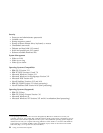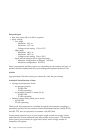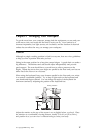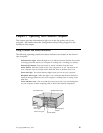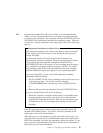
Configuring Your Computer
The Configuration/Setup Utility program enables you to view and change the
configuration and setup of your computer. The program is stored in the EEPROM
(electrically erasable programmable read-only memory) of your PC.
You can use the Configuration/Setup Utility program to view and change the
configuration and setup of your computer, regardless of which operating system
you are using. However, the settings you select in your operating system might
override any similar settings in the Configuration/Setup Utility program.
The following is a brief description of the categories that appear in the main menu
of the Configuration/Setup Utility program.
System Summary provides information about the current options and features
in your computer. Included in the system summary is information about the
microprocessor, memory, video controller, and diskette and hard disk drives.
Product Data contains information about the machine type and model, flash
EEPROM revision level, system-board identifier, system serial number, and
BIOS date.
Devices and I/O Ports allows you to view and change settings for devices and
I/O ports, including video, IDE drive, serial port, and parallel port settings.
Date and Time allows you to view and change the date and time of the internal
clock in your computer.
System Security allows you to control access to the hard disk and diskette
drives. You can also set, change, and delete power-on and administrator
passwords.
Start Options allows you to view and change settings for device startup
sequence, keyboard speed, virus detection, various power-on options, and other
features of your computer.
Advanced Setup allows you to view and change settings for advanced
hardware features, including ROM shadowing and microprocessor, memory,
and PCI control. The settings in Advanced Setup must be configured correctly.
If they are not, your computer might malfunction.
ISA Legacy Resources allows you to indicate which system resources (DMA,
interrupt, memory, and I/O port) are used by ISA legacy adapters.
Advanced Power Management allows you to view and change settings that
affect the energy-saving features of your computer, including the automatic
power-on feature.
22 Using Your Personal Computer



